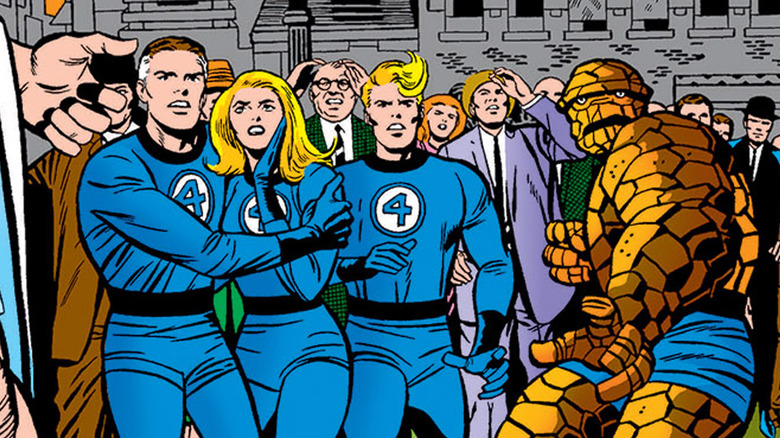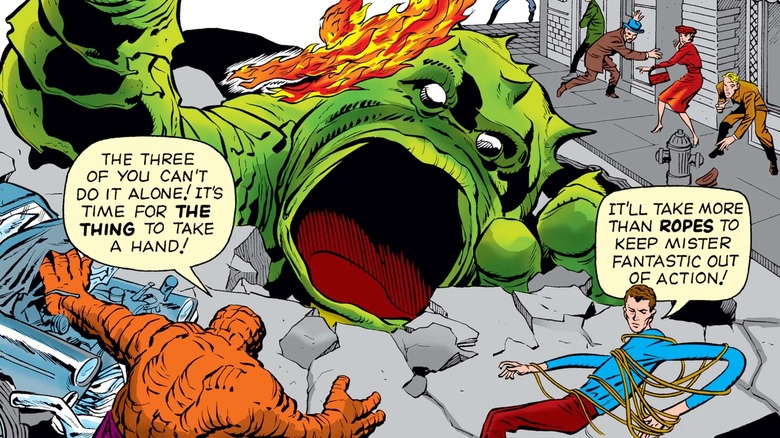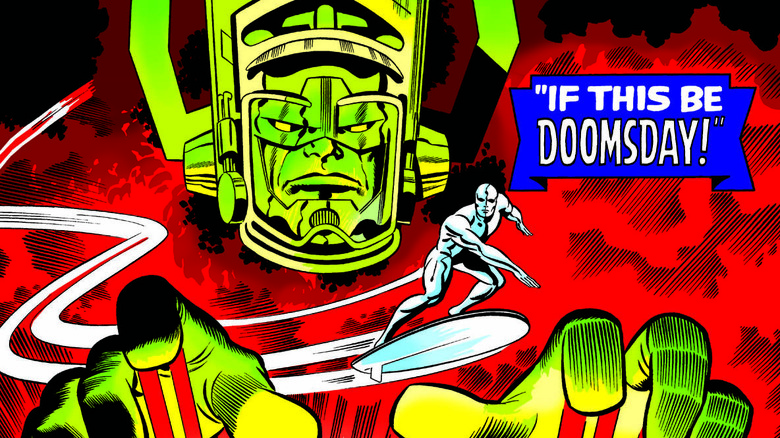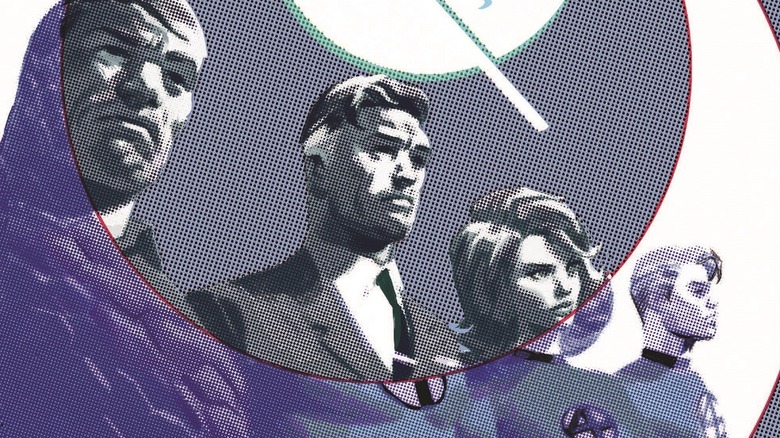Marvel Revealed The Fantastic Four Comics You Must Read Before The MCU Reboot
The Fantastic Four is coming to the Marvel Cinematic Universe, featuring Pedro Pascal as Reed Richards/Mister Fantastic, Vanessa Kirby as Sue Storm/Invisible Woman, Joseph Quinn as Johnny Storm/Human Torch, and Ebon Moss-Bachrach as Ben Grimm/The Thing. The team's return to live-action in the Matt Shakman-directed movie is exciting for numerous reasons, including the fact that he and his cast will be able to reinterpret some of the greatest comics to star Marvel's First Family. As for what those stories might be, well, Marvel has given us a hint through some recommendations on what comics to read ahead of their MCU debut.
Marvel recently shared a poster showcasing Joseph Quinn's look as the Human Torch as depicted by MCU concept artist Ryan Meinerding. With the post came a link to a 404-error page featuring H.E.R.B.I.E., the Fantastic Four's robot assistant, holding a coffee cup with the team's logo on it. To the side of H.E.R.B.I.E. is a faint QR code that leads directly to another page where you can read five free comics (after subscribing to the Marvel Unlimited digital comics app). The selected comics feature some of the team's most important classic tales along with a more modern story, all of which may offer a hint as to what "Fantastic Four" will offer fans when it releases in 2025.
But which comics did Marvel choose to spotlight, and what do they potentially tell us about the upcoming film?
The Fantastic Four #1 begins in 1961
The one that started it all, "Fantastic Four" #1 (by Jack Kirby, Stan Lee, George Klein, Christopher Rule, Stan Goldberg, and Artie Simek), is first on the list of comics to read, and for a good reason.
The debut issue introduces Marvel's First Family to readers, recounting the story of how a group of scientists snuck aboard a rocket during the Space Race with the Soviet Union and were exposed to cosmic rays, granting them incredible power — an origin that's remained largely intact to this day. The team bands together (without costumes, which they didn't receive until their third issue) and travels to Monster Isle, where they take on one of their most iconic villains (no, it's not Doctor Doom), Mole Man. Shunned by the world, the Fantastic Four foe makes the island his home and plans to use the monsters who live underground to get revenge on humanity.
"Fantastic Four" #1 sets the tone for the superteam's science fiction-themed adventures, introduces their power sets and personalities, and establishes Mole Man as one of their most notorious and long-lasting villains. While Kirby and Lee probably didn't realize it at the time of the issue's release, the comic set in motion a new age of heroes. Now, more than 60 years later, the Fantastic Four remain as relevant and influential as ever.
Fantastic Four #48 - 50 introduces Silver Surfer and Galactus
Considering the news that Marvel has cast Julia Garner as Shalla-Bal, the female Silver Surfer, there's a strong chance "Fantastic Four" is adapting one of the greatest comic stories ever told, "The Coming of Galactus."
In 1965, "Fantastic Four" #48 (by Jack Kirby, Stan Lee, Joe Sinnott, and Artie Simek) introduced the world-devouring threat of Galactus. In the story, the planet-eating cosmic entity targets Earth as the Watcher breaks his vow of non-interference. He tries to hide the planet from Galactus' herald, the Silver Surfer, while also warning the Fantastic Four of his pending arrival. Nonetheless, Galactus eventually finds himself at the FF's home, forcing the team to devise a plan to stop him. They work with the Surfer, who feels guilt over his actions, to try to redirect the cosmic threat away from their home world. In the end, the Human Torch retrieves a weapon known as the Ultimate Nullifier from Galactus' own worldship and uses the universe-destroying armament to prevent their gigantic foe from eating our planet.
"The Coming of Galactus" unfolds across three issues and is Kirby and Lee's magnum opus, an epic science fiction story that introduces multiple key Marvel characters with huge stakes throughout. The combination of the rumored 1960s setting of the upcoming "Fantastic Four" film with the introduction of Silver Surfer (and likely Galactus) means it would be surprising if Kirby and Lee's storyline did not serve as the primary inspiration for the movie. Introducing Galactus would bring a new and unique big bad to the universe, further expand the cosmic scope of the MCU, and open up new storytelling possibilities in terms of scale, setting, and more.
Fantastic Four: Life Story #1 remixes a classic origin
While those comics are obviously important based on what we know about the upcoming film, Marvel's inclusion of "Fantastic Four: Life Story" #1 (by Mark Russell, Sean Izaakse, Nolan Woodard, and Joe Caramagna) is a surprise. The series tells the tale of the team starting in the 1960s, but ages them as time passes and their story unfolds across the decades. The FF's origin remains rooted in the Cold War, but the heroes get older as they take on some of their most important adventures and battles. The comic recounts stories longtime readers are familiar with but presents them in new and interesting ways. For example, while Galactus arrives on Earth as in the main canon, and events unfold as they did in Kirby and Lee's run, they involve an older Fantastic Four team as opposed to the primary comic's structure where the characters don't age in real-time.
So, why would Marvel include a modern, time-sliding story on its list of must-read comics? Well, despite the "Fantastic Four" film appearing to offer a version of the FF that's based in the 1960s, there's no chance they'll remain there and not become part of the modern MCU timeline. Including "FF: Life Story" on the reading list hints that the movie will somehow bring the team from the '60s to the modern era, which makes sense since the promo art so far indicates that the heroes will be well-seasoned in their roles when audiences meet them. However, don't expect a similar 50-60-year jump in age like the characters experience in the comic, as Marvel Studios is looking at the team as a franchise, not a one-off movie.



